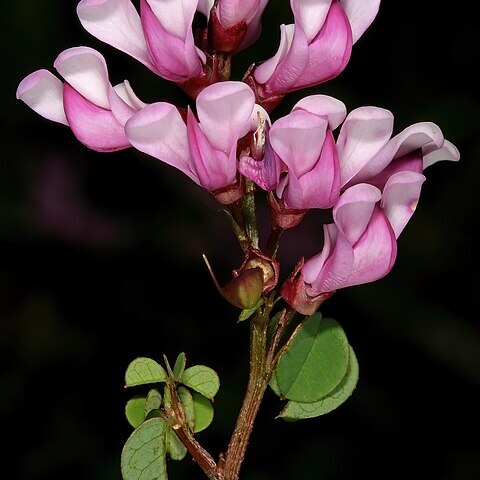Slender, usually dark reddish-black branches sometimes longitudinally sul-cate, glabrous or with sparse hairs on the youngest parts (occasionally, a form on the Potteberg, with hairs on small, conical projections from the branchlet surface). Leaves: Stipules linear-subulate (sub-filiform), 1-3 mm long, attenuating, glabrous or with some hairs on basal inner parts. Petiole usually 2.5-7 mm long on the fully developed leaves, glabrous, slender, suberect. Leaflets often drooping against the petiole, obovate-circular; petiolules about 0.7 mm long or less; laminae 3-11(-14) mm long and 4-8(-9.5) mm broad, rounded to slightly retuse at apex but midrib usually ending as a little cusp less than 0.5 mm long; upper leaflet surface darkish green, distinctly canaliculate along the midvein; lower surface pale green, with prominent midvein and partly reticulate, distinct lateral veinlets; mid-vein and base of leaflets sometimes with sparse hairs. Inflorescence a short terminal raceme usually with only 2-6 flowers, but in certain forms (in the Caledon-Genadendal regions) with as many as 15 flowers. Axis glabrous or sparsely hispid. Flowers in the axils of linear-subulate, narrow bracts usually 1-3 mm long, in some forms with a lateral tooth on each side. Pedicel 3.0-6.5 mm long, rather slender, usually glabrous. Bracteoles on the outer part of the pedicel, similar to the bract, usually persistent during anthesis, 0.5-1.5 mm long. Calyx purplish, glabrous or with a few short scattered hairs, drawn backwards at base at the onset of flowering, but narrowly campanulate in bud, during anthesis appearing short, only 3 mm or usually less along the median upper line. Upper two lobes united medially to a point only about 1 mm from the apices; lower incisions deeper; lobes deltoid-triangular, the lowest median lobe 0.7-1.2(-1.5) mm long. Petals. Vexillum and alae almost white to pale purplish, apically sometimes a deeper purple, the carina with deep or dark purple apex. Vexillum blade usually extremely small and almost hood-like, but sometimes rather large (variation discussed below), (2.8-)3.0-6.0(-9.0) mm long and 2.5-6.5(-8.5) mm broad, thus generally much shorter than the other petals, with more or less flat sides at an acute angle, with subacute or seldom rounded (occasionally retuse) apex; claw extremely short, usually less than 0.5 mm, on the inner side with two closely standing, lateral callus bodies c. 0.5 mm long. Ala blades elongate, (6.7-)7.5-9.2(-10.5) mm long and 2.3-3.0(-3.6) mm broad in the somewhat widened apical part, often slightly twisted, reaching well beyond the keel; basal upper parts with oblique or transverse folds; claws 0.8-1.8 mm long. Carina blade lunate and somewhat beaked, (4.3-)5.0-6.3(-6.9) mm long and 2.2-3.2 mm] broad; claws (1.0-)1.3-2.1 mm long. Stamens: Basifixed anthers about 0.5 mm long, dorsifixed ones about 0.4 mm. Pistil: Ovary with 3-7 ovules. Fruit a rather flat, obovate-fusiform] legume, pointed at both ends, usually 13-18 x 6-8 mm in size; stipe curved] somewhat backwards; when ripe with walls pale yellowish to intensely light-1 brown, somewhat papery, firm but not very hard. Ripe seeds usually solitary in each fruit, elliptic, about 3 x 2 mm, dark brown to black.
More
Sprawling shrublet, 0.1-0.6 m high; branches slender, usually dark reddish black, sometimes longitudinally sulcate, glabrous or with sparse hairs on young parts. Leaves digitately trifoliolate, petiolate, stipulate. Leaflets small, widely obovate, drooping, rounded to slightly retuse at apex. Inflorescence a short terminal raceme of 2-6(-15) flowers. Flowers pale purple to almost white. Calyx: tube glabrous. Flowering time July-Sept. Pod stipitate, ovate to obliquely oblong, flattened.
Sprawling, reseeding shrublet to 50 cm with wiry branches. Leaves 3-foliolate, leaflets small, broadly obovate, drooping. Flowers 2-6(-15) in lax, terminal racemes, pale purple to almost white, calyx glabrescent. Pods stipitate, ovate to obliquely oblong, flattened.

